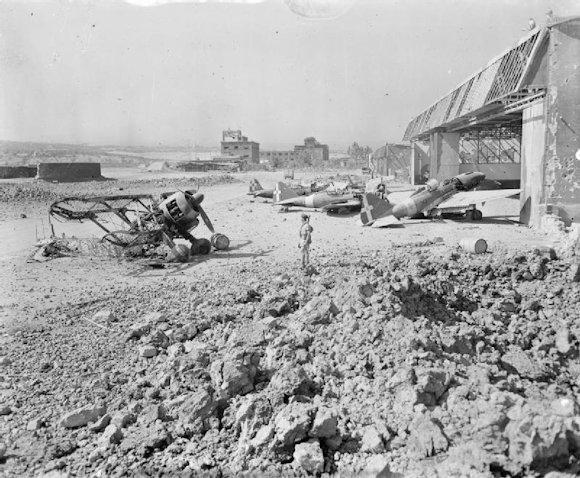When in the late spring of the 1943 the last Italian-German positions capitulated at the end of the extreme (and strategically impossible) attempt to hold Tunisia, the Allied forces found themselves for the first time concretely before the possibility of taking the strategic initiative in the middle long term on the western front after almost 4 years of war; the best Italian divisions and most of the German forces engaged in the theater of Mediterranean warfare had finally been vanquished in the North African bag. However, more than two months were needed before the Anglo-Americans managed to attack Sicily, the 10 in July; relying on just half of the divisions of the opponents (about German 4 at the most favorable time, against allied 8), without support, interdiction or air cover and in front of the total predominance of allied naval and land artillery (it would have been only one Anticipation of what would have happened in Normandy a year later), the Wehrmacht managed to contain the thrust of the invading army and to proceed to an orderly retreat towards the Italian mainland, in an overall situation in which the carrying out of the operation Zitadel in the Kursk salient it deprived the German forces of any real possibility of receiving further reinforcements that were not to be found in the redeployment of the evacuated forces from Corsica and Sardinia.
Of considerable importance for the development and outcome of the harsh island campaign was also the fact that a real German operational staff was created only a posteriori, at the end of the phase properly called Allied landing: up to that time it was present (under the command of Lieutenant General Von Senger und Etterlin, as a liaison officer with the VI armed Italian of General Guzzoni) only a communications company; this circumstance turned out to be more than decisive in the impossibility of being able even to hypothesize a coordinated counterattack of all the German forces when the allies had only the first bridgeheads on the beaches; only at the time of the collapse of the weak Italian divisions could this tactical handicap be compensated and also the reinforcement of the 29 ^ Panzergrenadier division in support of the 15 Panzergrenadier (moreover of fresh constitution, with inexperienced recruits) and the most robust Fallschirm Panzer Hermann Göring.
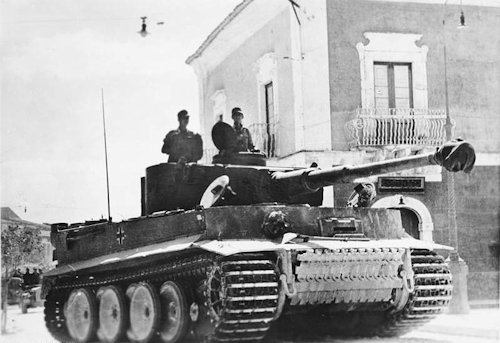 Two further problems prevented Etterlin from launching such a counterattack even when de facto German commanders took control of the axis operations in Sicily: as the general himself (a veteran of the Russian front, a specialist in tanks) could do present after the war, the allied solution to land virtually anywhere available on the coast between Syracuse and Licata with the extended front tactic immediately forced the panzers to operate fractionally in support of the increasingly unstable Italian infantry (to be taken into account was also the dramatically effective air interdiction of the Allied fighter-bombers), then it soon became clear that the space of the coastal plains of Gela and Catania would have absolutely not favorably lent itself to really important armored operations, also having regard to the considerable size of the German wagons of the new generation afterwards Stalingrad (element that did not emerge instead in the previous winter-spring operations in the large expanses of French North Africa). The most conspicuous panzer reserve composed of carts Tigre it was concentrated in the eastern part of the island with the division Hermann Goering; their task should have been to block any attempt by the Allied armored men to advance both from the plain of Catania and that of Gela and for this they launched their counterattack in a southerly direction starting from Caltagirone, but still managing to push the allies back to the end Coastal it was immediately clear that the losses due to the naval artillery were rather serious and that this tactical success was thwarted by the strategic impossibility to stabilize the front that in all the sectors between Syracuse and Licata was already collapsing causing the allies to flow towards the inside.
Two further problems prevented Etterlin from launching such a counterattack even when de facto German commanders took control of the axis operations in Sicily: as the general himself (a veteran of the Russian front, a specialist in tanks) could do present after the war, the allied solution to land virtually anywhere available on the coast between Syracuse and Licata with the extended front tactic immediately forced the panzers to operate fractionally in support of the increasingly unstable Italian infantry (to be taken into account was also the dramatically effective air interdiction of the Allied fighter-bombers), then it soon became clear that the space of the coastal plains of Gela and Catania would have absolutely not favorably lent itself to really important armored operations, also having regard to the considerable size of the German wagons of the new generation afterwards Stalingrad (element that did not emerge instead in the previous winter-spring operations in the large expanses of French North Africa). The most conspicuous panzer reserve composed of carts Tigre it was concentrated in the eastern part of the island with the division Hermann Goering; their task should have been to block any attempt by the Allied armored men to advance both from the plain of Catania and that of Gela and for this they launched their counterattack in a southerly direction starting from Caltagirone, but still managing to push the allies back to the end Coastal it was immediately clear that the losses due to the naval artillery were rather serious and that this tactical success was thwarted by the strategic impossibility to stabilize the front that in all the sectors between Syracuse and Licata was already collapsing causing the allies to flow towards the inside.
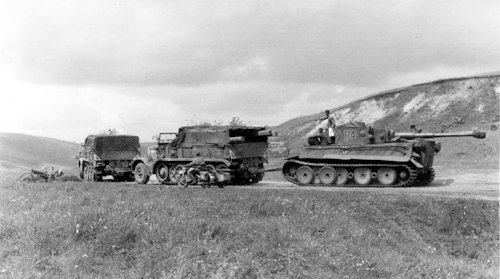 At the end of the conflict Senger was very precise in reconstructing the difficulties of the tank crews of the Göring and their courageous but unfortunate impact with the battle: the height and the armor made the Tigre not very mobile, bulky and unable to steer, not to mention that the narrow streets on mountainous areas were ideal corridors for American artillery observers and pounding allied fighter bombers; remarkable successes were also reported by the small groups of allied paratroopers near the main roads, where they were able to make masterly use of the covering of the olive trees and of the hunting-tank tactics; it also came too often to the finding that to move a Tigre in failure the only way was to tow it with 2 wagons of the same type, an ideal circumstance for enemy artillerymen to hit an easy target. However it was also evident that they had remarkable qualities: absolutely less vulnerable than stationary guns, always able to raise the morale of the infantry and able to facilitate the coordination of the defense groups engaged by the enemy fire with the use of their two-way radios; the more the Allied advance proceeded slowly the more they proved deadly as an anti-tank weapon, given that the narrow streets of Sicily still had the same defects even for the Anglo-Americans and not only for the Germans. Overall, however, all this could not have happened even in the slightest part if the British had immediately succeeded in forcing the blockade on the east coast, where the smaller distance towards Messina's strategic goal would undoubtedly have allowed Montgomery to cut the retreat to all Axis forces, and it is here that Student's men gave their decisive contribution to the battle. The British marshal was firmly determined to break through the plain of Catania starting from Lentini with a general attack on the night of 13 July, immediately after an airborne operation had been able to ensure him control of the bridge of Primosole on the Simeto river, located at few km south of Catania; for this the operation was implemented fustian, by the I Airborne Brigade British, under the command of Brigadier General Gerald Lathbury (future hero of Market Garden in Arnhem in September of the 44), that despite serious problems in gathering at least half of its staff at the agreed point, managed to surprise the Italian 50 guards around and take the bridge intact.
At the end of the conflict Senger was very precise in reconstructing the difficulties of the tank crews of the Göring and their courageous but unfortunate impact with the battle: the height and the armor made the Tigre not very mobile, bulky and unable to steer, not to mention that the narrow streets on mountainous areas were ideal corridors for American artillery observers and pounding allied fighter bombers; remarkable successes were also reported by the small groups of allied paratroopers near the main roads, where they were able to make masterly use of the covering of the olive trees and of the hunting-tank tactics; it also came too often to the finding that to move a Tigre in failure the only way was to tow it with 2 wagons of the same type, an ideal circumstance for enemy artillerymen to hit an easy target. However it was also evident that they had remarkable qualities: absolutely less vulnerable than stationary guns, always able to raise the morale of the infantry and able to facilitate the coordination of the defense groups engaged by the enemy fire with the use of their two-way radios; the more the Allied advance proceeded slowly the more they proved deadly as an anti-tank weapon, given that the narrow streets of Sicily still had the same defects even for the Anglo-Americans and not only for the Germans. Overall, however, all this could not have happened even in the slightest part if the British had immediately succeeded in forcing the blockade on the east coast, where the smaller distance towards Messina's strategic goal would undoubtedly have allowed Montgomery to cut the retreat to all Axis forces, and it is here that Student's men gave their decisive contribution to the battle. The British marshal was firmly determined to break through the plain of Catania starting from Lentini with a general attack on the night of 13 July, immediately after an airborne operation had been able to ensure him control of the bridge of Primosole on the Simeto river, located at few km south of Catania; for this the operation was implemented fustian, by the I Airborne Brigade British, under the command of Brigadier General Gerald Lathbury (future hero of Market Garden in Arnhem in September of the 44), that despite serious problems in gathering at least half of its staff at the agreed point, managed to surprise the Italian 50 guards around and take the bridge intact.
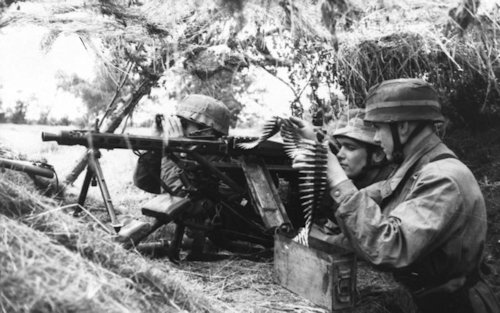 Everything went well until the German paratroopers of the 1 ^ Fallschirmjäger to wrest the bridge from the English, managing to defend it for 3 days of intense fighting; at that point, despite the 1 ^ paratroopers German had taken the bridge back, also thanks to the support efforts of the 50 ^ Northumbrian infantry division, For the '8 ^ armed British the opportunity for a rapid advance towards the Strait was definitively blurred given the providential contribution of the panzer echelons to reinforce the Fallschirmjäger who succeeded in greatly facilitating Senger's delaying actions in the area; Montgomery was then forced to coordinate his advance with the American columns of the 5 ^ armed that came from Palermo and started a slow movement towards the west to get around the massive Etna, circumstances that allowed the Wehrmacht to start the orderly withdrawal towards the continental Italy having at least one month at disposal.
Everything went well until the German paratroopers of the 1 ^ Fallschirmjäger to wrest the bridge from the English, managing to defend it for 3 days of intense fighting; at that point, despite the 1 ^ paratroopers German had taken the bridge back, also thanks to the support efforts of the 50 ^ Northumbrian infantry division, For the '8 ^ armed British the opportunity for a rapid advance towards the Strait was definitively blurred given the providential contribution of the panzer echelons to reinforce the Fallschirmjäger who succeeded in greatly facilitating Senger's delaying actions in the area; Montgomery was then forced to coordinate his advance with the American columns of the 5 ^ armed that came from Palermo and started a slow movement towards the west to get around the massive Etna, circumstances that allowed the Wehrmacht to start the orderly withdrawal towards the continental Italy having at least one month at disposal.
The greatest reason for relief from the Oberbefehlshaber Süd Kesselring was to be able to see how the Sicilian summer campaign ended with the allied tactical victory due to the conquest of the island without however that neither Patton nor Montgomery had succeeded in surrounding and annihilating the German divisions before that they could repair beyond the Strait of Messina and begin their retreat to the roads and railways of Campania and central-southern Italy in order to undertake their next and equally arduous mission: the strategic defense of Rome and the Apennine chain, fundamental to be able to continue to exploit the contribution of the productive and food resources of the industrial plants and of the agricultural lands of the occupied northern Italy.
In all, in August of 1943 in six days and seven nights, no less than German 60000 (some estimates arrive at 80000) they managed to reach Calabria bringing with them (unlike the English 3 years before in Dunkerque) a large part of the equipment .
(Keep it going...)
by Manuele Serventi Merlo and Federico Massa
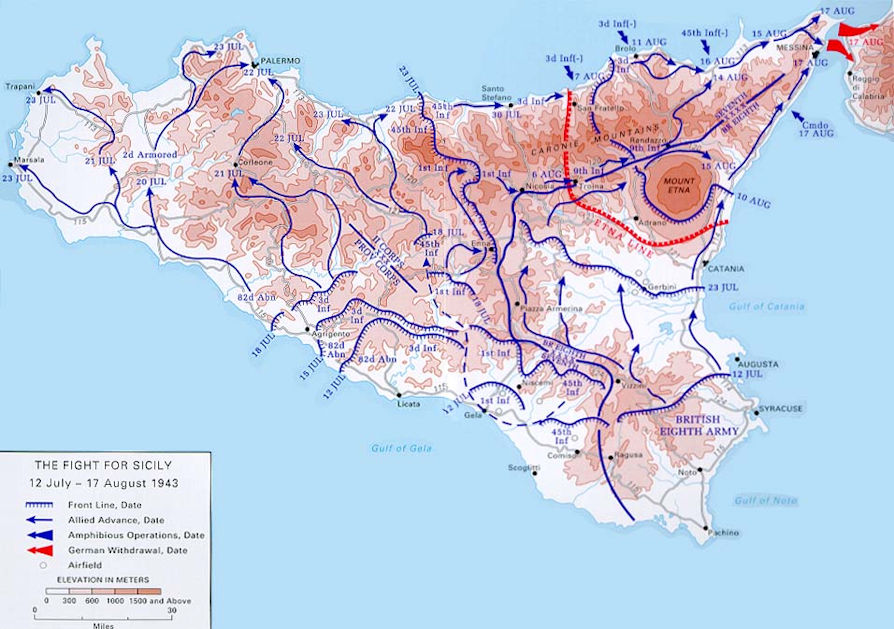 (photo: web)
(photo: web)

